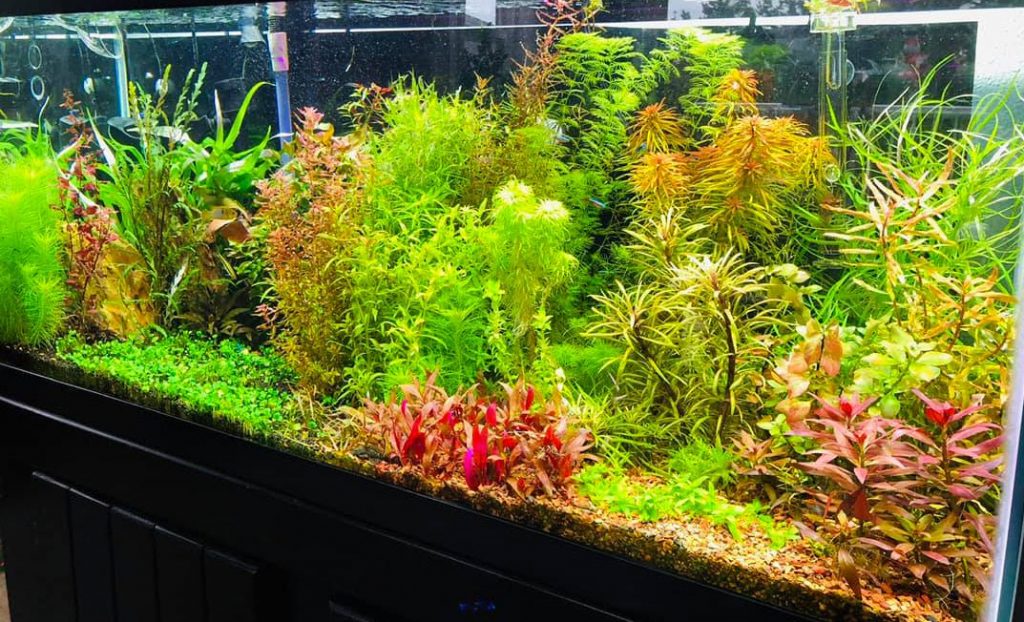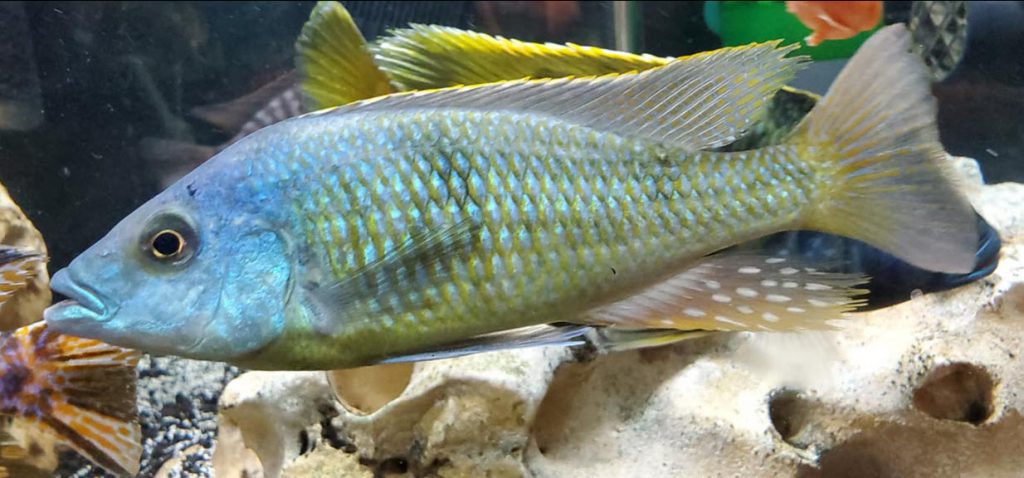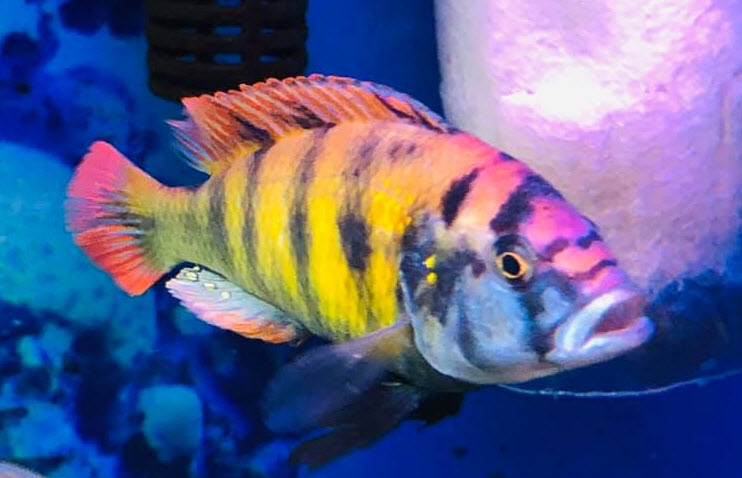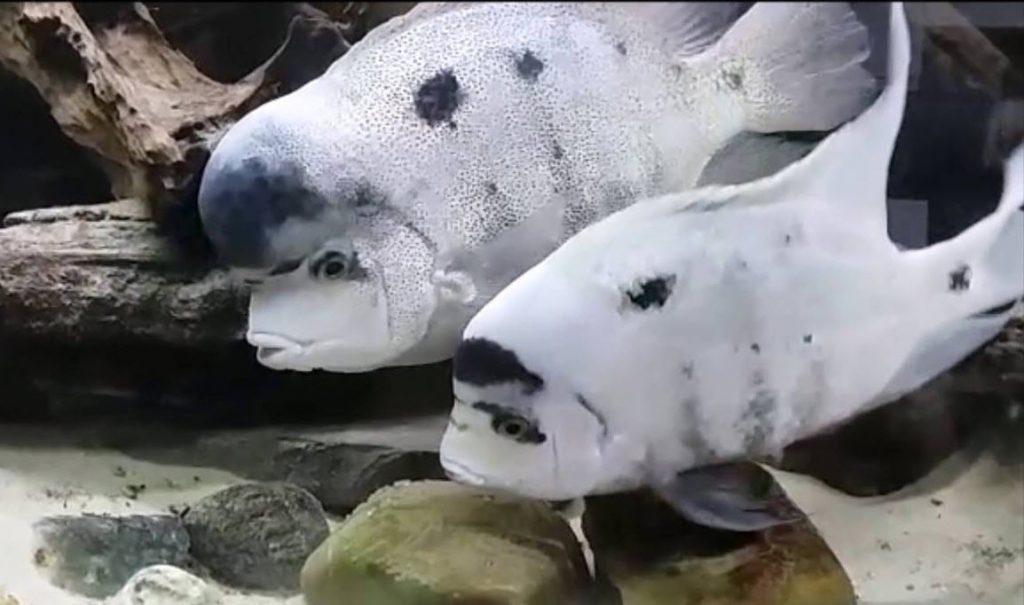
It is generally (but not universally!) accepted that fish will do better in an aquarium if some of the water is drained upon occasion and replaced with new clean water. This is called a “water change”. People drain and refill anywhere from 75% of the aquarium twice a week to 10% of the aquarium every month. Some do no water changes and have very healthy fish. A reasonable water change schedule for most hobbyists is:
.
50% water changes be done every one to three months
.
Now this is a generalized guideline based on typical stocking and feeding. We recommend only a greater than 50% water change every two weeks if very heavily stocked; every six weeks if moderately stocked, and every five months if lightly stocked.
Now there is one exception to this “schedule”. If the fish pant at the surface and appear to not be getting enough “air” after a big water change, one has to ask where the water originated. Does the municipal water supplier use wells? Or is the water from a private well? If the answer is yes there is a problem with large water changes.
Aerated water has 8 ppm oxygen in it. Well water can have zero oxygen in it. So a 50% water change with well water can take the oxygen level in the tank down to 4 ppm. Most topical fish get very distressed at 6 ppm and can die at 4 ppm. So only do a maximum of a 25% water change if one is on well water or pre-condition the well water by leaving it out for at least 24 hours.

Myths About Water Changes
A commentator on Facebook listed the “reasons to do a water change”. The commentator was sincere and trying to be helpful, but he inadvertently messed up the science. The actual Facebook comment was:
“Why hobbyist have a water change routine
-
- to replenish minerals
- balance redox potential
- to have stable parameters pH, dGH & dKH
- to control POC & DOC levels
- discourage proliferation of pathogens
- to reduce GIH growth inhibit hormone”
.
Wish I could sugar coat this but I cannot. EVERY single point here is just incorrect. EVERY one. Many will no doubt find this surprising, because all the reasons are myths that have become firmly entrenched in the hobby, perhaps even more deeply with the rise of social media.

The point by point analysis is:
- Food will more than replenish any minerals fish absorb.
- The importance of “redox potential” is a myth. Reduction/oxidation in the aquarium is an extremely complex topic that cannot be reduced to one number.
- The importance of pH, dGH and dKH being stable is a myth. In any case these parameters are only stabilized by a water change in the rare event of “old tank syndrome”.
- If one’s filtration is so bad that one has to remove particulate organic carbon (POC) and dissolved organic compounds (DOC) with water changes, one needs to become more familiar with how biofiltration works in the aquarium because one has very poor biofiltration and a VERY unhealthy environment for the fish.
- Pathogens like bacteria in the water column need to be reduced logarithmically, like by a factor of ten to one hundred. So unless one is doing like a 99% water change you are not helping your fish with pathogens.
- GIH (growth inhibiting hormone) has a half life of four minutes. So it never gets into the water in even parts per trillion concentrations. GIH only acts inside the fish, not outside the fish in the water.
This is unfortunately typical of the well meaning but erroneous advice often given over the internet.

Unfortunately there is a lot of misinformation in social media about water changes. Here are a few more detailed analyses of some of the water change myths.
Myth #1, Water Changes Must Keep Nitrate Levels Low
There is actually only one function of water changes, namely to reduce nitrates. And since nitrates are not very poisonous one simply doesn’t have to do water changes very often.
When ammonia is oxidized by the beneficial bacteria in an aquarium the result is nitrate. Nitrate reduction is the driving force behind water changes. Nitrates are ONLY reduced by water changes or plants.
Nitrate research shows nitrate is relatively innocuous to fish. Adult fish can take at least 160 ppm with no long-term effects. Some people have tap water with nitrates of 80 or more and they do just fine. Some people fertilize planted tanks to 80 ppm and the fish in those tanks do just fine.
Here is an article on nitrates which has many university paper references on what constitutes safe nitrate levels:
5.4. Safe Nitrate Levels

Because the API test doesn’t do a good job distinguishing between 40 ppm nitrate and 80 ppm nitrate, some people aim for very roughly below 40 ppm (red-orange but not red) and some people aim for below 80 ppm (red, but not dark red) on the nitrates with their water changes. Both are perfectly acceptable, very safe courses of action.
Many say one has to keep the level below 20 ppm of nitrate or even 10 ppm. There is no objective research justifying this extreme, there is only the opinions of well meaning but ill-informed individuals on social media. This is totally unnecessary and will just drive people out of the hobby because it starts making a very easy hobby very hard.
It is recommended one aim for nitrates lower than 80 ppm. This keeps algae growth somewhat under control. This level also reflect the fact that the very popular API test kit appears to be identical at the 40 and 80 nitrate levels. But many people keep their fish at higher nitrate levels (in some cases much higher levels) and that is fine. They are not “guilty of animal cruelty”. Also note the API test is notorious for giving high readings.

The Profit Motive
There are a host of charts and websites which say one should do a 50% water change once a week in order to have healthy fish. Everyone, and I mean EVERYONE, on social media parrots these recommendations, including your local fish store. Some simple calculations say that the market for aquarium water conditioners is about $150 million if hobbyists do 50% water changes once a week.
If typical hobbyists only change the water when the nitrate level goes to 80 ppm, or once every six weeks, then the yearly market for conditioners is only $25 million. So that basically is 125 million reasons for the charts and the recommendations. Isn’t the profit motive great?

Myth #2 Fish Get Their Minerals From Water Changes
There is a school of thought that fish get their “minerals” from the water through their gills. It is true that fish bring in sodium, calcium and magnesium through their gills. But aquarium fish will get very adequate amounts of these elements through their diet. So, the level of these elements would have to be very low in both the food and the water (dGH <1) before there is any sort of a problem. So “replenishing” these minerals is not a reason for changing water.
Also some of the minerals in the food pass through most fish unabsorbed and are excreted. This is always increasing the amount of minerals in the water. So the mineral content of the water actually becomes higher without water changes.

Myth #3 Water Changes Keep Fish Hormones in the Water Down
Some other inventive fish keepers say that there are fish growth hormones in the old water which need to be removed by water changes. This has no basis in science and is simply speculation by a person who doesn’t understand the meaning of proving an hypothesis. There is no research by any university confirming ANY fish put out ANY growth hormones to the water to ANY detectable levels.
Fish growth hormones are very short lived complex chemicals with half lives measured in 2 to 4 minutes (“The effects of somatostatin on serum growth hormone levels in the goldfish, Carassius auratus”. Cook et al, 1984, “The influence of mammalian and teleost somatostatins on the secretion of growth hormone from goldfish [Carassius auratus L.] pituitary fragments in vitro,” Marchant et. al., 1987, “Somatostatin inhibits growth of rainbow trout,” Very et. al., 2005, “Neuroendocrine Regulation of Growth Hormone Secretion and Growth in Fish,” Peng et. al. 1997).
This means that in ten minutes the fish hormones produced by a fish are virtually gone, decomposed. There isn’t enough time to have the hormones get into the water in any quantities sufficient to affect the fish at all.
And in any case a water change even every 24 hours cannot possible have any effect on the levels of said hormones in the water. Four minutes is 0.3% of 24 hours. So even if one did a 100% water change AND all the hormones produced in a fish entered the water instead of the fish, in a few minutes the hormone levels would be almost 100% of the levels prior to the water change.

Myth #4 Water Changes Keep pH Stable
Others claim they change water frequently to keep the pH stable. These folks are referring to “old tank syndrome”, a rapid drop in pH in an aquarium due to high nitrate levels. There are two general conditions for old tank syndrome;
- The pH and dKH of the water need to be low, lower than 6.5 pH and 1 dKH
- The nitrates typically (but not always) must be very high, on the order of well over 200 ppm (i.e. someone must be very lax in their water changes)
These conditions are only rarely met in an aquarium. So, keeping the pH stable with water changes is another myth.

Myth #5, Water Changes Give Healthy Fish
Still another myth repeated constantly in social media is that water changes are very beneficial for sick fish. “Clean water” IS the key to fish health. But the “clean” referred to is the bacterial count in the water. A count of one billion bacteria per milliliter is bad, ten million, moderate and ten thousand great. So one has to reduce bacteria by factors of 100 (one billion divided by ten million is one hundred), not by 50%. The relationship is “logarithmic”.
A typical 50% water change has no effect what-so-ever on fish bacterial pathogens. If the problem has to do with bacteria in the water, bacteria in the water columns need to be reduced logarithmically to be effective. For instance a 99% water change will effectively reduce a high bacterial count. A 50% water change will be ineffective in reducing a high bacterial count. Going from 1 billion bacteria to 500 million bacteria doesn’t help very much.

Myth #6, Water Changes Greater than 20%, 30%, 40% or 50% (pick a number) “Shock” the Fish and need to Be Avoided
This myth is just incredibly wrong. Fish in a lake and in a river constantly swim through what are called “thermoclines” which not only differ considerably in temperature but also differ in water chemistry (pH and Carbon Dioxide). Over some 53 years I’ve done many 95% water changes with absolutely no problem.
Many researchers have looked a “shock hormones” that fish produce and found they only produce those hormones with VERY large changes in parameters, like going from 80 degrees F to 60 degrees F or going from 8.0 pH to 6.0 pH. And the fish only produce shock hormones, they don’t die.
For more on this topic go to this link:
4.8. Stability isn’t Important
If one has a problem with a tank such as a very high ammonia or nitrite spike or a lot of algae growth due to high phosphates and nitrate, a 95% water change is a very beneficial thing to do. And there will be no “shock” to the fish.

Further Research
There are some aquarium hobbyists who are interested in delving deep into the science and the calculations behind all aspects of the hobby. For those who are so inclined the following is pertinent:
18.1. Aquarium Water Changes
18.1.2. Water Change Math
18.1.3. Water for Water Change
18.2. Continuous Drip Water Change Systems
.
Return to Maintenance Menu
.
Aquarium Science Website
The chapters shown below or on the right side in maroon lead to close to 400 articles on all aspects of keeping a freshwater aquarium. These articles have NO links to profit making sites and are thus unbiased in their recommendations, unlike all the for-profit sites you will find with Google. Bookmark and browse!
.

Dave says
In reply to anonymous ….. Generally yes, unless you are regularly trimming and removing plants.
Anonymous says
Hi Dave,
If I am dosing a liquid fertilizer (like EasyGreen) on a regular basis, does that necessesitate regular water changes to prevent anything from building up?
Dave says
I respectfully disagree as it is a myth. There are no sensitive strains of shrimp.
Tommy says
Some of these I would actually agree with the myths. Granted you are talking about fish aquariums but for some people that have shrimp some of the myths are actually things you should look out for. Some of these shrimp that are bred for their colors don’t have the genetics for non stable environments. Some of the minerals will leave through plants and water changes sometimes maybe not even for years.
Dave says
In reply to Mary …. It is one of these references: “The effects of somatostatin on serum growth hormone levels in the goldfish, Carassius auratus”. Cook et al, 1984, “The influence of mammalian and teleost somatostatins on the secretion of growth hormone from goldfish [Carassius auratus L.] pituitary fragments in vitro,” Marchant et. al., 1987, “Somatostatin inhibits growth of rainbow trout,” Very et. al., 2005, “Neuroendocrine Regulation of Growth Hormone Secretion and Growth in Fish,” Peng et. al. 1997
Mary says
Hey Dave. Thanks again for this site and for answering so many questions. I’m having a discussion with a breeder about GIH and was wondering if you had a reference for just the fact that GIH has a half life of 2-4 minutes. I found something before but can’t seem to find it again. Thanks for everything you do.